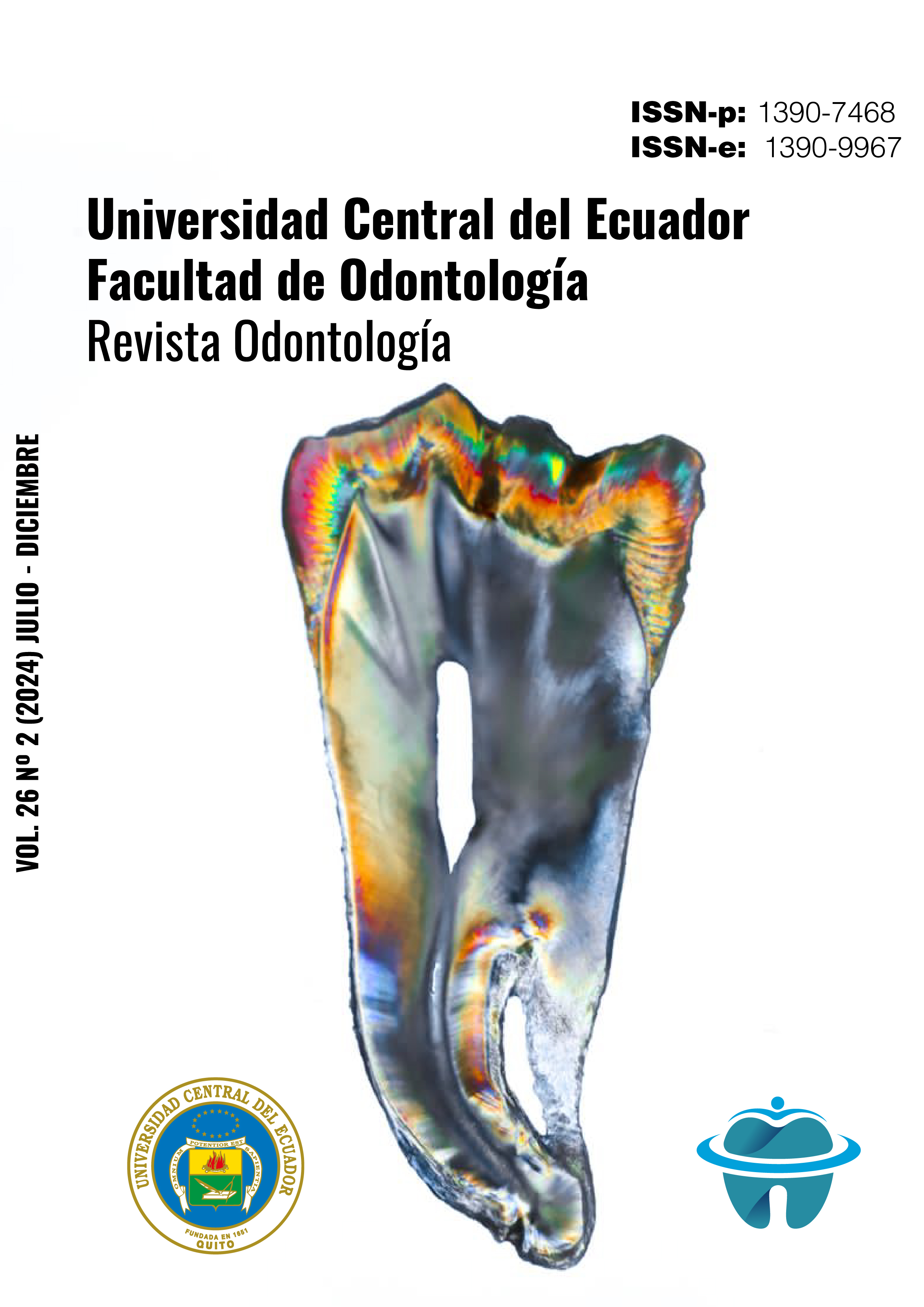HACCP system to improve the safety of dental units
DOI:
https://doi.org/10.29166/odontologia.vol26.n2.2024-e6744Keywords:
coliforms, water quality, Infant Dentistry, HACCPAbstract
Objective: To implement a Hazard Analysis and Critical Control Points (HACCP) system to improve the quality of water in the dental units of a university in the Colombian Caribbean. Methodology: The seven principles of the HACCP system were considered, with the installation of two high-tech, six-stage reverse osmosis systems. An internal audit and a preliminary microbiological analysis were conducted as prerequisites for system development. Results: A physical hazard was found in the bottle-filling stage of the dental units and at the entry point of the water line from the external source, with an increase in total coliform species and Escherichia coli. Consequently, it was necessary to establish critical control points (CCPs) in the process and to develop control measures for critical limits, along with monitoring schemes and corrective actions in case of deviations. Record updates were applied for the verification and control of the various system points. Conclusion: An improved system of control and disinfection of the dental units was achieved, enhancing the quality of dental services.
Downloads
References
Bayani M, Raisolvaezin K, Almasi-Hashiani A, Mirhoseini SH. Bacterial biofilm prevalence in dental unit waterlines: a systematic review and meta-analysis. BMC Oral Health. 2023;23(1):158. https://bmcoralhealth.biomedcentral.com/articles/10.1186/s12903-023-02885-4
O’Donnell MJ, Boyle MA, Russell RJ, Coleman DC. Management of dental unit waterline biofilms in the 21st century. Future Microbiol. 2011;6(10):1209–26. https://www.futuremedicine.com/doi/10.2217/fmb.11.104
DEPAOLA LG, MANGAN D, MILLS SE, COSTERTON W, BARBEAU J, SHEARER B, et al. A review of the science regarding dental unit waterlines. J Am Dent Assoc. 2002;133(9):1199–206. https://linkinghub.elsevier.com/retrieve/pii/S0002817714635911
Costa D, Mercier A, Gravouil K, Lesobre J, Delafont V, Bousseau A, et al. Pyrosequencing analysis of bacterial diversity in dental unit waterlines. Water Res. 2015;81:223–31. https://linkinghub.elsevier.com/retrieve/pii/S0043135415300476
Zhang Y, Ping Y, Zhou R, Wang J, Zhang G. High throughput sequencing-based analysis of microbial diversity in dental unit waterlines supports the importance of providing safe water for clinical use. J Infect Public Health. 2018;11(3):357–63. https://linkinghub.elsevier.com/retrieve/pii/S1876034117302514
Tuvo B, Totaro M, Cristina ML, Spagnolo AM, Di Cave D, Profeti S, et al. Prevention and Control of Legionella and Pseudomonas spp. Colonization in Dental Units. Pathogens. 2020;9(4):305. https://www.mdpi.com/2076-0817/9/4/305
Wirthlin MR, Marshall GW, Rowland RW. Formation and Decontamination of Biofilms in Dental Unit Waterlines. J Periodontol. 2003;74(11):1595–609. https://aap.onlinelibrary.wiley.com/doi/10.1902/jop.2003.74.11.1595
Szymańska J, Sitkowska J. Bacterial contamination of dental unit waterlines. Environ Monit Assess. 2013;185(5):3603–11. http://link.springer.com/10.1007/s10661-012-2812-9
Alkhulaifi MM, Alotaibi DH, Alajlan H, Binshoail T. Assessment of nosocomial bacterial contamination in dental unit waterlines: Impact of flushing. Saudi Dent J. 2020;32(2):68–73. https://linkinghub.elsevier.com/retrieve/pii/S1013905219304134
Dyck A, Exner M, Kramer A. Experimental based experiences with the introduction of a water safety plan for a multi-located university clinic and its efficacy according to WHO recommendations. BMC Public Health. 2007;7(1):34. https://bmcpublichealth.biomedcentral.com/articles/10.1186/1471-2458-7-34
Spagnolo AM, Sartini M, Cristina ML. Microbial Contamination of Dental Unit Waterlines and Potential Risk of Infection: A Narrative Review. Pathogens. 2020;9(8):651. https://www.mdpi.com/2076-0817/9/8/651
World Health Organization (WHO). Guidelines for drinking-water quality: Fourth edition incorporating the first and second [Internet]. 4° Edicion. 2022. http://www.ncbi.nlm.nih.gov/books/NBK579461/
Osimani A, Aquilanti L, Babini V, Tavoletti S, Clementi F. An eight-year report on the implementation of HACCP in a university canteen: impact on the microbiological quality of meals. Int J Environ Health Res. 2011;21(2):120–32. http://www.tandfonline.com/doi/full/10.1080/09603123.2010.515669
BERLINGIERI F, BRUNO A, NJEUMI F, CAVIRANI S. Evolución de la cooperación entre la Organización Mundial de sanidad animal (OIE) y la Comisión del Codex Alimentarius. Rev Sci Tech l’OIE. 2007;26(3):607–17. https://doc.oie.int/dyn/portal/index.xhtml?page=alo&aloId=30704
Tsitsifli S, Tsoukalas DS. Water Safety Plans and HACCP implementation in water utilities around the world: benefits, drawbacks and critical success factors. Environ Sci Pollut Res. 2021;28(15):18837–49. http://link.springer.com/10.1007/s11356-019-07312-2
Published
How to Cite
Issue
Section
License
Copyright (c) 2024 José Amable Araujo-Blanco, Jorge Homero Wilches-Visbal, Midian Clara Castillo-Pedraza, Rosa Lía Bustillo-Verbel, Angela Edith Coral-Córdoba, Cristian Camilo Morales-Lastre

This work is licensed under a Creative Commons Attribution-NonCommercial-NoDerivatives 4.0 International License.


